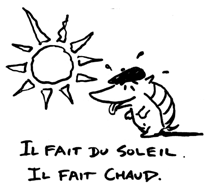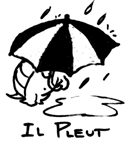Chapter 2: Préparons notre voyage
Learning Outcomes for Chapter 2
I can
- Count in French (Compter en français)
- Talk about important dates, like your birthday (Parler des dates importantes de la vie, comme votre anniversaire et les fêtes)
- Recognize nouns, gender, and number (Reconnaître les noms, le genre, et le nombre)
- Talk about time (Parler de l’heure et se situer dans le temps)
- Talk about the weather (Parler du temps)
Activities
Interpretive – take information from a calling card for TV5 Monde; read a weather forcast
Interpersonal – share information in class with your classmates such as age, phone numbers, and address
Presentational – present today’s date, time, and weather in a video
Cultural – explore differences in francophone countries regarding the use of numbers: counting, telephone numbers, and age.
Révisons les salutations
On Continue – Comptez en français
Before we go any further preparing our virtual trip to France, we need to learn to count in French. Counting in a new language is one of the most essential skills you can learn. So let’s get started with Alexa, who will pronounce each number for you. You may need to watch the video a few more times to practice.
Tout le monde ensemble! Comptons jusqu’à 20.
Très bien! Now, a little exercise to help you identify numbers 1-20.
Exercises
Bravo! Let’s learn more with Alexa.
Compter jusqu’a 100
Révisons: An Explanation and Review
For 70-79, you’re really saying 60 + #. So , for the number 74, for example, you’re actually saying 60 + 14 = soixante-quatorze. Eccentric, I know, but great for developing math skills. Take a look at 70-79:
70: soixante-dix
71: soixante et onze
72: soixante-douze
73: soixante-treize
74: soixante-quatorze
75: soixante-quinze
76: soixante-seize
77: soixante-dix-sept
78: soixante-dix-huit
79: soixante-dix-neuf
Ok, now, the 80s and 90s. For 80, you’ll literally say 4 20s = quatre-vingts, and then you add on from there:
80: quatre-vingts 90: quatre-vingt-dix
81: quatre-vingt-un 91: quatre-vingt-onze
82: quatre-vingt-deux 92: quatre-vingt-douze
83: quatre-vingt-trois 93: quatre-vingt-treize
84: quatre-vingt-quatre 94: quatre-vingt-quatorze
85: quatre-vingt-cinq 95: quatre-vingt-quinze
86: quatre-vingt-six 96: quatre-vingt-seize
87: quatre-vingt-sept 97: quatre-vingt-dix-sept
88: quatre-vingt-huit 98: quatre-vingt-dix-huit
89: quatre-vingt-neuf 99: quatre-vingt-dix-neuf
et CENT!
To count beyond 100, do some math. For example:
137 – cent trente-sept
454 – quatre cent cinquante-quatre
And Beyond!
1000 = mille
1999 = mille neuf cent quatre-vingt-dix-neuf
2005 = deux mille cinq
2024 = deux mille vingt-quatre
Le Numéro de téléphone, l’adresse, et la prononciation
In Belgium: 514 285 19 53 = cinq-cent-quatorze, deux-cent-quatre-vingt-cinq, dix-neuf, cinquante-trois.
In France: 01 44 18 55 55 = zéro-un, quarante-quatre, dix-huit, cinquante-cinq, cinquante-cinq.
In Quebec: 514 285 1841 = cinq-cent-quatorze, deux-cent-quatre-vingt-cinq, dix-huit-cent-quarante-et-un.
In Switzerland: 4121-312 68 17 = quarante-et-un-vingt-et-un, trois-cent-douze, soixante-huit, dix-sept.
Pratiquons!
à Vous!
Quel est votre numéro de téléphone à la française?
— — — — —
Quel est votre numéro de téléphone à la québecoise?
— — —-
Quel est votre adresse?
___________________________________________
Les noms
Le masculin – le féminin
Le singulier – le pluriel
This brings up an important issue: what to count? We count nouns, of course! You remember what a noun is, a person, place or thing.
In French nouns have a gender, either masculin or feminin. And they can be either singular (just one) or plural (more than one). Some nouns are gendered obviously: a woman is a feminine noun, a boy is a masculine noun. Others you have to memorize, such as a table or a cell phone. It’s best to memorize the gender of each noun as you learn it. Plurals are often shown just by adding an s to the end, but of course, there are irregular plurals that create exceptions. More on that later.
| la femme | une femme | les femmes | des femmes |
| la chaise | une chaise | les chaises | des chaises |
| l’homme | un homme | les hommes | des hommes |
| le portable | un portable | les portables | des portables |
| le garçon | un garçon | les garçons | des garçons |
la femme, une femme (feminine noun) les femmes. des femmes (plural feminine noun) – la chaise, une chaise (feminine noun) les chaises, des chaises (plural feminine noun)
le garçon, un garçon (masculine noun) les garçons, des garçons (plural masculine noun), l’homme, un homme (masculin noun). les hommes, des hommes – le portable, un portable (masculine noun) les portables, des portables (plural masculine noun). Note that the l’ is used before a vowel or a silent h.
l’, le, la, and les are definite articles: the woman/women, the chair/chairss, the boy/boys, the man/the men, the cell phone/cell phones (or laptop)
un, une, and des are indefinite articles : a woman/some women, a table/some tables, a boy/some boys, a cell phone/some cell phones
Note the difference in prononciation between le / les and de / des.
Pratique
Now, let’s count some common objects using the expression “Combien de … ?” We will answer with “Il y a … ”
Combien de femmes? Il y a _____ femmes dans la salle de classe.
Combien d’hommes? Il y a _____ hommes dans la salle de classe.
Combien de chaises? Il y a _____ chaises dans la salle de classe.
Combien de portables? Il y a _____ portables dans la salle de classe.
Combien de professeurs?
Combien d’étudiant.e.s? Attention! Un groupe d’hommes + femmes = on emploie le masculin. Il y a ____ étudiants dans la salle de classe.
Combien de chiens ? Attention! Il n’y a pas de chiens dans la salle de classe.
Quel âge avez-vous? Quel âge as-tu?
In this video, we see people say how old they are. All the way to 100 years old!
Now, more discussion on how asking how old someone is.
Examples
Watch this short 3 minute video from Coffee Break. Learn how to ask the question “How old are you” in French, and then listen carefully to learn how old each person is. Don’t worry! It will replay with subtitles to help you make sense of this real French. When you’re ready, prepare to answer the question yourself at the end of the video, and then in the activities!
La question: Quel âge avez-vous?
La réponse: J’ai 22 ans.
A vous!
Les mois de l’année
Quels sont les mois de l’année?
Et les saisons?
| l’hiver | le printemps | l’été | l’automne |
Quel mois en quel saison?
| décembre | mars | juin | septembre |
| janvier | avril | juillet | octobre |
| février | mai | août | novembre |

(en hiver) |

(au printemps) |

(en été- les vacances!) |
 (en automne) (en automne) |
Les jours de la semaine
Ecoutez la prononciation des jours de la semaine:
Quelle est la date de ton anniversaire? What is your birthday?
La question
Remember we mentionned briefly in the first module that in the past the French celebrated their saint’s feast day. Nowadays, in a country of people of many names, faiths and cultures, that tradition has been replaced by a recognition of birthdays to celebrate. Joyeux anniversaire! Here is a quick song to help you memorize the question: Quelle est la date de ton anniversaire? First note the extra letters on Quelle. The interrogative adjective agrees with ‘la date’ the feminine noun. You can’t hear the difference between quel/quelle (except in poetry). This song will help you learn the days of the month as well.
Quelle est la date de votre anniversaire? Réponse: C’est (le 4 avril, deux mille trois.)
A vous maintenant!
L’heure
In French, we ask the time in one of two ways :
- Quelle heure est-il ? (informel ).
- Est-ce que vous avez l’heure (formel) / Est-ce que tu as l’heure ? (informel).
Your answer is
“Il est” + the hour + minutes – il est huit heures – Il est 8h00. (Notice that there is an s on heures).
Il est une heure – il est 1h00. Heures becomes heure (singular) in this case because there is only one hour.
Regardez la vidéo.
Official Time: Official or Military time is set according to the 24 hour clock. This is used to express official time, such as for movie times, meeting times, and train or bus schedules.
In order to express this time, at 12 to any hour past 12PM (noon).
-1 PM is “une heure,” unofficially, but “treize heures,” officially (13h).
-3:30 PM is “trois heures et demie (de l’après midi),” unofficially, but “quinze heures trente,” officially (15h30).
-9:40 AM is “dix heures moins vingt,” unofficially, and “neuf heures quarante,” officially (09h40).
When using the 24 hour clock, unofficial terms such as “et demie” or “moins le quart” are not used.
Le Temps et La Météo
la météo
The verb faire is used in many weather expressions, expressions that are impersonal.

| Quel temps fait-il? What’s the weather like? |
| Il fait beau. It’s beautiful. |
| Il fait chaud. It’s hot. |
| Il fait du brouillard. It’s foggy. |
| Il fait du soleil. It’s sunny. |
| Il fait du vent. It’s windy. |
| Il fait frais. It’s cool. |
| Il fait froid. It’s cold. |
| Il fait mauvais. It’s bad. |
![]()
Other weather expressions which do not use faire include:
| Il pleut. It’s raining. |
| Il neige. It’s snowing. |
| Il y a du soleil. There’s a lot of sun. |
| Il y a du vent. It’s windy. |
Quel temps fait-il aujourd’hui?
Exercice
Quel temps fait- il à Paris aujourd'hui?
Et à Nice?
Et à Strasbourg?
woman, wife
the chair
the boy
man
(mobile) phone or laptop
How many?
There is, there are
today

